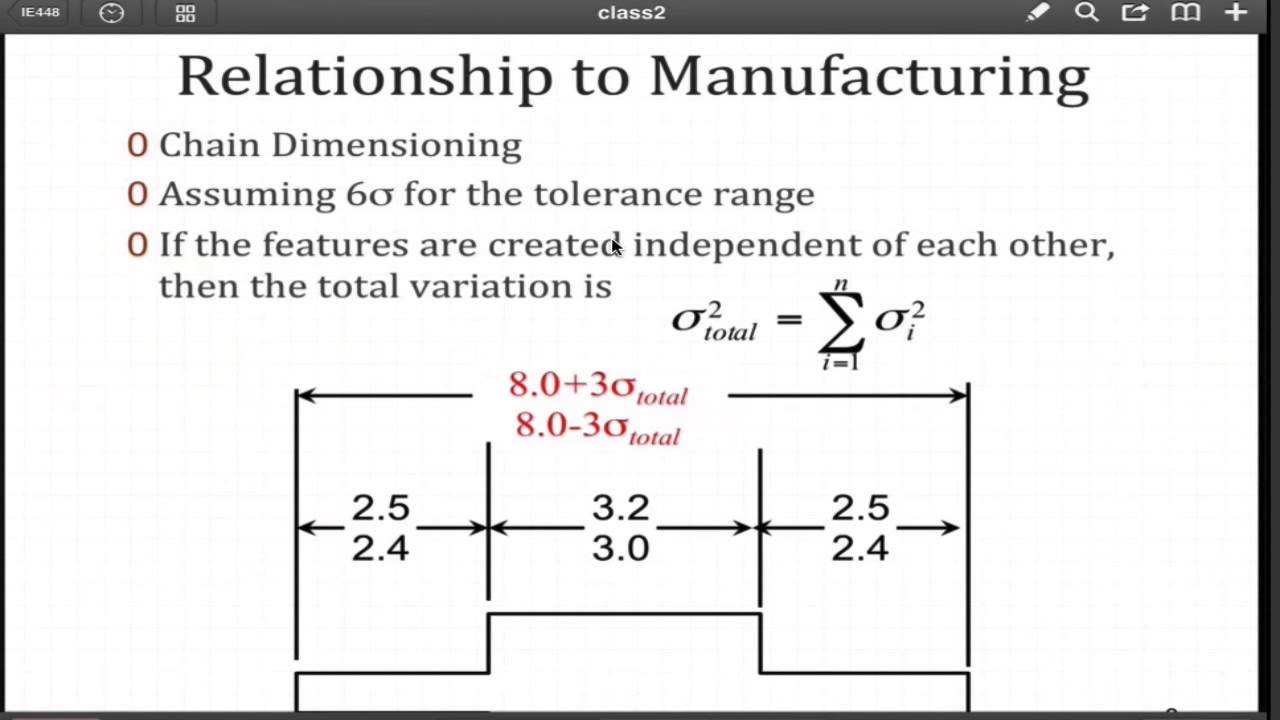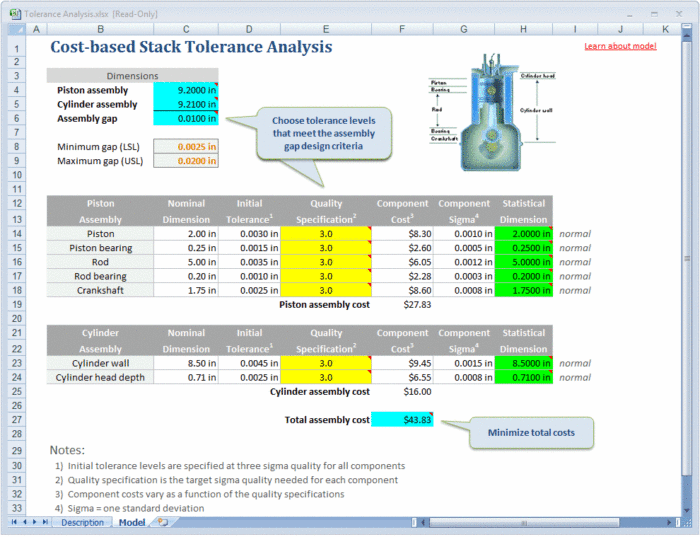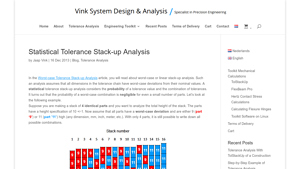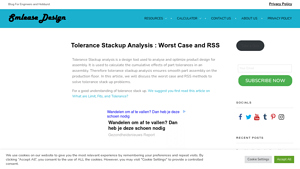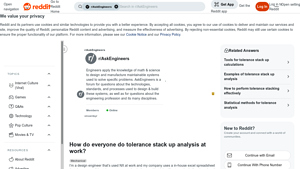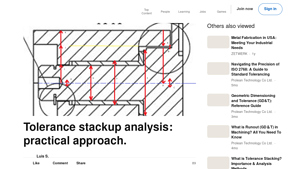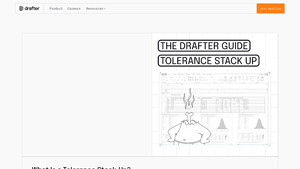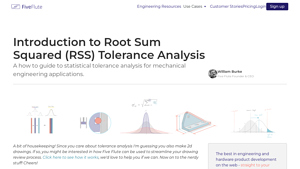Stack Up Tolerance Calculation Guide: Type, Cost, Top List…
Introduction: Navigating the Global Market for stack up tolerance calculation
In the competitive landscape of international manufacturing, understanding stack up tolerance calculation is crucial for businesses striving to maintain product quality while minimizing costs. A common challenge faced by B2B buyers, especially in regions such as Africa, South America, the Middle East, and Europe, is ensuring that the tolerances of interconnected parts do not lead to costly production errors. This guide offers a comprehensive examination of stack up tolerance calculation, covering essential topics such as various types of tolerance analysis, practical applications in different industries, and strategies for supplier vetting.
By delving into best practices and methodologies, this resource equips decision-makers with the insights needed to make informed purchasing choices. Buyers will learn how to effectively assess tolerance requirements, understand the implications of different analysis methods, and evaluate supplier capabilities to meet stringent quality standards. Furthermore, the guide addresses cost considerations, helping businesses balance precision with budgetary constraints. As a result, it empowers international B2B buyers to enhance their manufacturing processes, reduce waste, and ultimately improve their bottom line, ensuring they remain competitive in the global market.
Understanding stack up tolerance calculation Types and Variations
| Type Name | Key Distinguishing Features | Primary B2B Applications | Brief Pros & Cons for Buyers |
|---|---|---|---|
| Worst Case Tolerance Analysis | Assumes maximum deviations for all features; conservative approach | Aerospace, medical devices | Pros: Ensures high reliability; Cons: Tighter tolerances can increase costs. |
| Statistical Tolerance Analysis (RSS) | Utilizes statistical methods to estimate tolerances; considers variations | Mass production, automotive | Pros: More realistic; allows for larger production runs; Cons: Requires statistical expertise. |
| Monte Carlo Simulation | Uses random sampling to assess tolerance effects; comprehensive | Complex assemblies, electronics | Pros: Provides detailed insights; Cons: Computationally intensive and time-consuming. |
| Stack-Up Analysis with GD&T | Integrates Geometric Dimensioning and Tolerancing principles; emphasizes feature relationships | Precision engineering, tooling | Pros: Enhances communication between design and manufacturing; Cons: Can be complex to implement. |
| Tolerance Analysis for Assembly | Focuses on the fit of multiple components in an assembly; ensures functional performance | Consumer products, machinery | Pros: Ensures proper assembly function; Cons: May overlook individual part tolerances. |
What are the Key Features of Worst Case Tolerance Analysis?
Worst Case Tolerance Analysis is characterized by its conservative approach, assuming that all parts will be at their maximum allowable deviations. This method is particularly suitable for high-stakes industries like aerospace and medical devices, where precision is critical. Buyers should consider the potential for increased costs due to tighter tolerances, which may not be feasible for high-volume production but are essential when quality cannot be compromised.
How Does Statistical Tolerance Analysis (RSS) Benefit B2B Buyers?
Statistical Tolerance Analysis, often employing the Root Sum Squares (RSS) method, offers a more realistic view by considering the likelihood of various deviations across multiple components. This method is especially beneficial in mass production environments, such as automotive manufacturing, where slight variations are permissible. Buyers should weigh the advantages of increased production flexibility against the need for statistical expertise to effectively implement this analysis.
What Are the Advantages of Monte Carlo Simulation in Tolerance Analysis?
Monte Carlo Simulation provides a thorough examination of tolerance effects by utilizing random sampling techniques. This method is particularly advantageous for complex assemblies, such as those found in electronics, where interactions between parts can significantly affect performance. While it offers detailed insights, buyers must be prepared for the computational demands and time required to conduct these simulations effectively.
How Does Stack-Up Analysis with GD&T Improve Communication?
Stack-Up Analysis that incorporates Geometric Dimensioning and Tolerancing (GD&T) principles emphasizes the relationships between features in a design. This method is vital in precision engineering and tooling, where clear communication between design and manufacturing teams is essential. Buyers should appreciate the enhanced clarity this approach provides, although they may encounter complexity in its application.
Why is Tolerance Analysis for Assembly Critical in Product Design?
Tolerance Analysis for Assembly focuses on ensuring that multiple components fit together correctly to achieve desired functionality. This analysis is crucial in industries such as consumer products and machinery, where assembly performance directly impacts product usability. Buyers should consider how this analysis not only safeguards the fit of assembled parts but also highlights the importance of individual component tolerances, which should not be overlooked in the design process.
Key Industrial Applications of stack up tolerance calculation
| Industry/Sector | Specific Application of stack up tolerance calculation | Value/Benefit for the Business | Key Sourcing Considerations for this Application |
|---|---|---|---|
| Aerospace | Tolerance analysis in aircraft component assembly | Ensures safety and performance, reducing risk of failure | High precision materials, stringent quality certifications, and reliable suppliers are essential. |
| Automotive | Engine assembly and transmission systems | Enhances performance and reliability, minimizing warranty claims | Sourcing components that meet OEM specifications and industry standards is critical. |
| Medical Devices | Tolerance stacking in surgical instruments and implant manufacturing | Guarantees patient safety and compliance with regulatory standards | Look for suppliers with ISO certifications and experience in medical-grade materials. |
| Electronics | Tolerance analysis in PCB assembly and electronic enclosures | Improves product reliability, reducing returns and enhancing brand reputation | Supplier capability in precision manufacturing and adherence to electronic industry standards is vital. |
| Consumer Goods | Assembly of complex household appliances | Reduces production costs and increases product quality | Consider local suppliers for shorter lead times and logistics efficiency, especially in emerging markets. |
How is ‘stack up tolerance calculation’ utilized in the aerospace industry?
In the aerospace sector, stack up tolerance calculation is critical for ensuring that aircraft components fit together precisely. For instance, in aircraft assembly, components such as wings and fuselage must align accurately to maintain structural integrity and safety. By employing tolerance analysis, manufacturers can identify potential misalignments before production, reducing costly rework and enhancing compliance with stringent safety regulations. International buyers in this sector must prioritize suppliers who can demonstrate high precision and adherence to aerospace standards.
What role does stack up tolerance calculation play in automotive applications?
In automotive manufacturing, tolerance stacking is essential for engine and transmission assembly. Components need to fit together seamlessly to ensure optimal performance and reliability. By calculating tolerances, manufacturers can preemptively identify issues that could lead to engine failure or suboptimal performance. B2B buyers in this industry should focus on sourcing parts that meet OEM specifications and have proven durability, as this directly impacts the vehicle’s overall quality and customer satisfaction.
How is stack up tolerance calculation applied in medical device manufacturing?
Medical devices, such as surgical instruments and implants, require precise tolerances to ensure patient safety and compliance with regulatory standards. Tolerance analysis helps manufacturers ensure that all components fit together correctly, preventing malfunctions that could jeopardize patient health. Buyers in the medical field should seek suppliers with ISO certifications and experience in working with medical-grade materials, as these factors are crucial for meeting stringent industry requirements.
Why is stack up tolerance calculation important in electronics manufacturing?
In the electronics industry, stack up tolerance calculation is vital for the assembly of printed circuit boards (PCBs) and electronic enclosures. Precise tolerances ensure that components fit together correctly, which improves product reliability and reduces the risk of failures. Buyers should prioritize suppliers who specialize in precision manufacturing and are familiar with electronic industry standards, as this can significantly impact product performance and customer satisfaction.
How does stack up tolerance calculation benefit consumer goods manufacturing?
For consumer goods, such as complex household appliances, stack up tolerance calculation helps manufacturers reduce production costs while enhancing product quality. By analyzing tolerances, businesses can identify inefficiencies in assembly processes and optimize designs for better manufacturability. B2B buyers in this sector should consider sourcing from local suppliers to improve lead times and logistics, especially in emerging markets where efficiency can be a competitive advantage.
3 Common User Pain Points for ‘stack up tolerance calculation’ & Their Solutions
Scenario 1: Misalignment Caused by Cumulative Tolerances
The Problem: In high-precision manufacturing environments, such as aerospace or automotive sectors, a common challenge arises when multiple components must fit together within strict tolerances. For example, if a client orders a series of parts for an engine assembly, each part may have its own tolerances. If these tolerances are not carefully analyzed, the cumulative effect could lead to misalignment, causing parts to fit poorly or, worse, fail entirely during operation. This scenario not only delays production but can also lead to significant financial losses due to scrap and rework.
The Solution: To prevent misalignment issues, B2B buyers should implement a thorough stack-up tolerance analysis early in the design phase. Start by gathering detailed drawings of all components involved and their associated tolerances. Utilize statistical tolerance analysis methods, such as the Root Sum Squared (RSS), to estimate the overall tolerance for the assembly. This method allows for a realistic view of how individual tolerances interact, providing a more accurate prediction of fit and function. Engaging with specialized software tools that automate this analysis can significantly improve accuracy and save time. Additionally, collaborating with suppliers to ensure they understand the critical tolerances can further mitigate risks.
Scenario 2: Overly Tight Tolerances Leading to Increased Costs
The Problem: Many manufacturers fall into the trap of specifying overly tight tolerances in an attempt to ensure quality. For instance, a buyer may require components to be produced with tolerances of ±0.01 mm, not realizing that this will substantially increase manufacturing costs and time. Such stringent requirements can lead to difficulties in sourcing materials and may push suppliers to utilize more expensive manufacturing techniques, ultimately affecting the project budget and delivery timelines.
The Solution: To address this challenge, it is crucial to reassess the actual functional requirements of the assembly. Begin by conducting a functional analysis to identify which components truly require tight tolerances and which can be relaxed without compromising the product’s performance. Implement a collaborative design review with engineers and suppliers to discuss feasible tolerances based on manufacturing capabilities. By adopting a more pragmatic approach to tolerancing—considering both the function and manufacturability of parts—buyers can optimize production costs while maintaining quality. Regular training for engineering teams on tolerance management can also foster a better understanding of how to balance cost and precision effectively.
Scenario 3: Inadequate Communication Leading to Errors
The Problem: In international B2B transactions, particularly in regions like Africa and South America, communication barriers can lead to misunderstandings regarding tolerances and specifications. A manufacturer may receive a design that lacks clarity on critical tolerances, resulting in the production of parts that do not meet the necessary standards. This miscommunication can cause significant delays in the supply chain, impacting project timelines and damaging relationships between buyers and suppliers.
The Solution: To mitigate the risk of miscommunication, B2B buyers should establish clear documentation practices that include comprehensive tolerance specifications. Utilize visual aids such as engineering drawings and tolerance charts that leave no room for ambiguity. Employing standardized formats for tolerance specifications, such as Geometric Dimensioning and Tolerancing (GD&T), can enhance clarity. Additionally, fostering a culture of open communication with suppliers can help address potential issues before they escalate. Regular virtual meetings or workshops can be invaluable in ensuring that all parties understand the expectations and requirements, promoting a smoother workflow throughout the production process.
Strategic Material Selection Guide for stack up tolerance calculation
How to Choose the Right Material for Stack Up Tolerance Calculation?
Selecting the appropriate material for stack up tolerance calculations is critical for ensuring product performance and manufacturability. Different materials offer unique properties that can significantly impact the final product’s success. Below, we analyze four common materials used in various industries, focusing on their properties, advantages, disadvantages, and considerations for international B2B buyers.
What Are the Key Properties of Aluminum for Stack Up Tolerance Calculation?
Aluminum is widely used in manufacturing due to its lightweight nature and excellent strength-to-weight ratio. It exhibits good corrosion resistance and can withstand moderate temperatures, making it suitable for various applications. Its machinability allows for tight tolerances, which is essential for stack up calculations.
Pros and Cons: Aluminum is durable and relatively cost-effective, especially in high-volume applications. However, it can be more expensive than other metals like steel, and its lower tensile strength may limit its use in high-stress applications.
Impact on Application: Aluminum is compatible with various media, including water and air, but may not be suitable for aggressive chemicals.
Considerations for International Buyers: Buyers from regions like Africa and the Middle East should be aware of compliance with standards such as ASTM and ISO. Additionally, the availability of aluminum alloys may vary by region, influencing procurement decisions.
How Does Stainless Steel Perform in Stack Up Tolerance Calculations?
Stainless steel is renowned for its corrosion resistance and high strength, making it ideal for applications requiring durability and hygiene, such as food processing and medical devices. Its ability to maintain structural integrity at elevated temperatures enhances its suitability for various environments.
Pros and Cons: The primary advantage of stainless steel is its longevity and resistance to harsh conditions. However, it is generally more expensive than aluminum and can be challenging to machine, leading to potential complications in achieving tight tolerances.
Impact on Application: This material is compatible with a wide range of media, including corrosive substances, making it versatile for many industries.
Considerations for International Buyers: Compliance with standards such as ASTM and EN is crucial for stainless steel products. Buyers should also consider the availability of specific grades, as preferences may vary by region.
What Are the Benefits of Using Plastics in Stack Up Tolerance Calculations?
Plastics, particularly engineering-grade polymers, are increasingly used in manufacturing due to their lightweight properties and versatility. They can be formulated to achieve specific characteristics, such as high temperature resistance or enhanced chemical compatibility.
Pros and Cons: Plastics are generally lower in cost and easier to process than metals, allowing for complex geometries and tight tolerances. However, they may not offer the same level of durability or heat resistance as metals, which can limit their applications.
Impact on Application: Plastics can be tailored to be compatible with various chemicals, making them suitable for industries like pharmaceuticals and food packaging.
Considerations for International Buyers: Buyers should be aware of regional regulations regarding plastic materials, including compliance with food safety standards in Europe and South America.
How Does Carbon Steel Compare for Stack Up Tolerance Calculations?
Carbon steel is favored for its high strength and affordability. It can be heat-treated to enhance its properties, making it suitable for applications requiring high load-bearing capabilities.
Pros and Cons: The main advantage of carbon steel is its cost-effectiveness and strength. However, it is prone to corrosion and may require protective coatings, which can complicate manufacturing processes.
Impact on Application: Carbon steel is compatible with a variety of media but may not be suitable for corrosive environments without additional treatment.
Considerations for International Buyers: Compliance with standards such as ASTM and DIN is important. Buyers should also consider the regional availability of different grades of carbon steel, as this can affect lead times and costs.
Summary Table of Material Selection for Stack Up Tolerance Calculation
| Material | Typical Use Case for Stack Up Tolerance Calculation | Key Advantage | Key Disadvantage/Limitation | Relative Cost (Low/Med/High) |
|---|---|---|---|---|
| Aluminum | Aerospace components, automotive parts | Lightweight and corrosion-resistant | Lower tensile strength | Medium |
| Stainless Steel | Medical devices, food processing equipment | High strength and durability | More expensive and challenging to machine | High |
| Plastics | Consumer products, packaging | Cost-effective and versatile | Lower durability compared to metals | Low |
| Carbon Steel | Structural components, machinery | Cost-effective and strong | Prone to corrosion | Low |
Choosing the right material involves balancing performance, cost, and manufacturing considerations while ensuring compliance with international standards. Understanding these factors will help B2B buyers make informed decisions that align with their specific industry needs.
In-depth Look: Manufacturing Processes and Quality Assurance for stack up tolerance calculation
How Do Typical Manufacturing Processes Impact Stack Up Tolerance Calculation?
The manufacturing process for components subject to stack up tolerance calculations involves several critical stages: material preparation, forming, assembly, and finishing. Each stage plays a vital role in ensuring that the final product meets the required tolerances, which directly affects the overall quality and performance of the assembled parts.
What Are the Main Stages of the Manufacturing Process?
-
Material Preparation: This initial stage involves selecting the appropriate materials based on the specifications of the final product. Material selection must consider factors such as strength, weight, and thermal properties. Prior to processing, materials may undergo treatments like annealing or heat treatment to enhance their mechanical properties. This phase also includes cutting materials to rough dimensions, which sets the foundation for precise tolerances.
-
Forming: During the forming stage, materials are shaped into the desired configurations using techniques such as machining, casting, or forging. Each technique has its implications for tolerance control. For example, machining can achieve tighter tolerances compared to casting, which may introduce variability due to the nature of the material flow during solidification. Careful control of parameters such as temperature and pressure during forming is crucial to minimize discrepancies.
-
Assembly: The assembly stage is where individual components come together to form a complete product. It is essential to consider the cumulative tolerances of each part in the assembly to ensure proper fit and functionality. Techniques such as jigs and fixtures can be employed to maintain alignment and repeatability during assembly. This stage often requires iterative testing and adjustment to achieve the required specifications.
-
Finishing: The final stage, finishing, involves processes that enhance the product’s surface quality and overall performance. Techniques such as grinding, polishing, and coating are commonly employed to achieve the desired surface finish. This stage is also critical for meeting specific tolerances that may not have been achieved in earlier processes. The finishing process can significantly influence the final dimensions and tolerances of the product.
How Do Quality Assurance Processes Influence Stack Up Tolerance Calculation?
Quality assurance (QA) is integral to the manufacturing process, particularly for stack up tolerance calculations. The implementation of robust QA practices ensures that components meet international standards and customer expectations.
What Are the Relevant International Standards for Quality Assurance?
International standards such as ISO 9001 provide a framework for quality management systems, emphasizing customer satisfaction and continuous improvement. Additionally, industry-specific standards like CE (Conformité Européenne) for products sold in the European market and API (American Petroleum Institute) for oil and gas components ensure that manufacturers adhere to specific safety and quality requirements. Compliance with these standards is crucial for international B2B transactions, as they provide a level of assurance regarding product quality.
What Are the Common Quality Control Checkpoints?
Quality control (QC) checkpoints are critical throughout the manufacturing process to ensure adherence to specifications. Key QC checkpoints include:
-
Incoming Quality Control (IQC): This involves inspecting raw materials and components upon arrival to ensure they meet specified standards before they enter production.
-
In-Process Quality Control (IPQC): Continuous monitoring during manufacturing helps detect and rectify deviations from tolerances in real-time. This checkpoint is essential for minimizing scrap rates and rework.
-
Final Quality Control (FQC): The final inspection is conducted before products are shipped to customers. This step verifies that the finished goods meet all required specifications and tolerances.
What Are the Common Testing Methods for Quality Assurance?
Testing methods vary depending on the product and industry but typically include:
-
Dimensional Inspection: Using tools like calipers and micrometers to measure physical dimensions against specifications.
-
Functional Testing: Assessing whether the assembled product performs as intended under specified conditions.
-
Non-Destructive Testing (NDT): Techniques such as ultrasonic testing and X-ray inspection are used to evaluate material integrity without damaging the components.
How Can B2B Buyers Verify Supplier Quality Control?
For B2B buyers, particularly those in Africa, South America, the Middle East, and Europe, verifying a supplier’s quality control processes is paramount. Here are several approaches:
-
Supplier Audits: Conducting regular audits of suppliers can provide insights into their quality management practices, production capabilities, and adherence to industry standards.
-
Quality Reports: Requesting detailed quality reports from suppliers can help assess their compliance with agreed-upon specifications and standards. This includes documentation of inspection results, testing methodologies, and corrective actions taken.
-
Third-Party Inspections: Engaging independent third-party inspection services can provide an unbiased evaluation of a supplier’s quality control processes and product quality. These inspections can be particularly valuable for international transactions where trust is critical.
What Are the Quality Control and Certification Nuances for International B2B Buyers?
For international B2B buyers, understanding the nuances of quality control and certification is essential. Different regions may have varying requirements for certifications, which can affect product acceptance in local markets. For example, products sold in Europe may require CE marking, while those in the Middle East may need to adhere to specific local standards.
Additionally, cultural differences in business practices and communication can impact the effectiveness of quality assurance efforts. Establishing clear communication channels and expectations with suppliers can help mitigate misunderstandings and ensure that quality standards are met consistently.
Conclusion
In conclusion, the interplay between manufacturing processes and quality assurance is crucial for successful stack up tolerance calculations. By understanding the typical manufacturing stages, relevant quality standards, control checkpoints, and testing methods, B2B buyers can make informed decisions and ensure that their suppliers meet the necessary quality requirements. This diligence not only enhances product reliability but also strengthens business relationships in the global marketplace.
Practical Sourcing Guide: A Step-by-Step Checklist for ‘stack up tolerance calculation’
To successfully procure stack up tolerance calculation services, it’s essential to follow a structured approach. This guide provides a checklist to help B2B buyers streamline their sourcing process, ensuring they select the right partners for their tolerance analysis needs.
Step 1: Define Your Technical Specifications
Clearly articulate your project’s technical requirements, including the precision and tolerance levels necessary for your components. This step is critical as it sets the foundation for communication with potential suppliers. Ensure that you document all relevant parameters, such as the dimensions, material types, and specific manufacturing processes involved.
Step 2: Research and Identify Qualified Suppliers
Conduct thorough research to identify suppliers who specialize in stack up tolerance calculations. Look for companies with a proven track record in your industry, particularly those that have experience with similar projects. Utilize industry networks, trade shows, and online platforms to gather a list of potential suppliers.
- Check online reviews and testimonials to assess their reputation.
- Focus on suppliers that operate in your target regions, such as Africa, South America, the Middle East, and Europe, to ensure they understand local market dynamics.
Step 3: Evaluate Supplier Expertise and Capabilities
Assess each supplier’s expertise in tolerance analysis methods, such as Worst Case Tolerance Analysis and Statistical Tolerance Analysis (RSS). Understanding their proficiency in these methods will help you gauge their ability to meet your specific needs.
- Request case studies or examples of previous work that illustrate their capabilities.
- Inquire about their technical team’s qualifications and experience.
Step 4: Request Detailed Proposals
After narrowing down your list, request detailed proposals from each supplier. Proposals should outline their approach to tolerance stacking, including methodologies, timelines, and pricing structures. This is a vital step to understand how they plan to address your specific requirements.
- Compare the methodologies proposed by each supplier to ensure they align with your project needs.
- Look for transparency in pricing to avoid unexpected costs later.
Step 5: Verify Compliance with Industry Standards
Ensure that potential suppliers comply with relevant industry standards and certifications, such as ISO 9001 for quality management. Compliance indicates that they adhere to rigorous quality processes, which is essential for minimizing errors in tolerance calculations.
- Ask for documentation of their certifications.
- Check if they have undergone recent audits or assessments.
Step 6: Conduct Supplier Visits or Virtual Meetings
If possible, conduct site visits or virtual meetings to better understand the supplier’s operations and culture. This interaction can provide insights into their processes and help build a relationship based on trust and communication.
- Observe their facilities and quality control measures.
- Discuss potential challenges and solutions directly with their team.
Step 7: Establish Clear Communication Channels
Before finalizing your supplier choice, establish clear communication channels to facilitate ongoing discussions throughout the project. Good communication is crucial for addressing any issues that may arise during the tolerance calculation process.
- Determine preferred communication methods (e.g., email, project management tools).
- Set regular check-in meetings to review progress and address concerns.
By following this step-by-step checklist, B2B buyers can effectively navigate the procurement process for stack up tolerance calculations, ensuring they select a supplier that meets their technical and operational needs.
Comprehensive Cost and Pricing Analysis for stack up tolerance calculation Sourcing
What Are the Key Cost Components in Stack Up Tolerance Calculation?
When engaging in stack up tolerance calculations, various cost components come into play that collectively influence the overall pricing structure. Understanding these elements is crucial for international B2B buyers looking to optimize their sourcing strategies.
Materials are a primary cost driver. The choice of raw materials significantly impacts pricing, especially when dealing with specialized components that may require higher-grade materials for precision applications. For example, using high-strength alloys or engineered plastics can elevate costs but may be necessary for ensuring product reliability and performance.
Labor costs also factor prominently into the equation. Skilled labor is essential for executing precise tolerancing techniques and performing the necessary analyses. This is particularly relevant in regions where labor costs may vary significantly. For instance, sourcing from countries with lower labor costs can offer competitive pricing, but it’s important to ensure that the workforce has the requisite skills for complex tasks.
Manufacturing overhead encompasses indirect costs related to the production process, such as utilities, facility maintenance, and administrative expenses. These costs are often distributed across all products manufactured and can vary depending on the efficiency and scale of operations.
Tooling costs should not be overlooked. The initial investment in specialized tools and machinery for creating components that adhere to stringent tolerances can be substantial. However, effective tooling can lead to long-term cost savings through increased production efficiency and reduced waste.
Quality Control (QC) measures are crucial for maintaining the integrity of the tolerance stack-up process. The cost associated with QC can include testing, inspections, and certifications. For international buyers, understanding the quality standards required in their respective markets is vital, as this can influence both costs and pricing.
Logistics costs involve the transportation and handling of materials and finished products. International buyers must consider factors such as shipping fees, customs duties, and the reliability of supply chains, particularly when sourcing from regions like Africa and South America, where logistical challenges may arise.
Margin is the final component that suppliers factor into their pricing. The margin needs to be competitive yet sufficient to ensure the supplier’s sustainability. Understanding the typical margins within the industry can provide buyers with leverage during negotiations.
What Influences Pricing in Stack Up Tolerance Calculation?
Several price influencers can affect the final cost of stack up tolerance calculation services and products.
Volume/MOQ (Minimum Order Quantity) is a significant factor. Suppliers often provide discounts for bulk purchases, making it beneficial for buyers to consolidate orders when possible. This approach not only reduces unit costs but can also streamline logistics.
Specifications and customization requirements can lead to price adjustments. Highly specialized tolerances may require advanced manufacturing techniques, which can increase costs. Buyers should clearly communicate their needs to avoid unexpected expenses.
Materials and their associated costs are also critical. As previously mentioned, the choice of material can have a direct impact on pricing. Buyers should weigh the benefits of high-quality materials against their budget constraints.
Quality and certifications play an essential role, especially for buyers in regulated industries such as aerospace and medical devices. Ensuring that suppliers have the necessary certifications can prevent costly quality failures down the line.
Supplier factors, including their reputation, location, and production capabilities, can influence pricing. Established suppliers with a proven track record may command higher prices, but they often provide greater reliability and quality assurance.
Incoterms can also affect the overall cost. Understanding the terms of shipment and responsibility for costs can help buyers manage their total expenses more effectively.
What Tips Can Help Buyers Negotiate Better Prices?
For B2B buyers, particularly those in Africa, South America, the Middle East, and Europe, effective negotiation strategies can lead to significant cost savings.
-
Negotiation tactics should focus on building relationships with suppliers, understanding their constraints, and leveraging bulk purchasing agreements to secure better pricing.
-
Cost-efficiency should be a priority. Buyers should analyze the Total Cost of Ownership (TCO) rather than just the upfront costs. This includes considering maintenance, logistics, and potential quality issues.
-
Pricing nuances for international buyers often involve understanding local market conditions, currency fluctuations, and geopolitical factors that may influence costs.
By being informed about these cost components and pricing influencers, international B2B buyers can make strategic decisions that enhance their sourcing efficiency and overall profitability.
Disclaimer
The prices discussed in this analysis are indicative and may vary based on specific circumstances, including market conditions, supplier negotiations, and regional economic factors.
Alternatives Analysis: Comparing stack up tolerance calculation With Other Solutions
Understanding the various options available for tolerance analysis is crucial for manufacturers aiming to optimize production quality and efficiency. By comparing stack up tolerance calculation with alternative methods, B2B buyers can make informed decisions that align with their operational needs and business goals.
| Comparison Aspect | Stack Up Tolerance Calculation | Monte Carlo Simulation | Worst Case Tolerance Analysis |
|---|---|---|---|
| Performance | High accuracy for complex assemblies | Moderate accuracy; depends on sample size | Guarantees all parts are within tolerance |
| Cost | Moderate; requires software tools and expertise | High; software licenses and computational resources needed | Low; simple calculations, minimal tools required |
| Ease of Implementation | Moderate; requires understanding of GD&T principles | Complex; needs statistical knowledge and software | Easy; straightforward calculations |
| Maintenance | Low; once implemented, minimal updates needed | High; requires ongoing management of simulation parameters | Low; infrequent recalculations unless designs change |
| Best Use Case | Complex assemblies with multiple interacting parts | High-volume production with acceptable variability | Low-volume, high-precision parts |
What are the Advantages and Disadvantages of Monte Carlo Simulation for Tolerance Analysis?
Monte Carlo Simulation is a statistical technique that uses random sampling to estimate the probability of different outcomes in a process that cannot easily be predicted due to the intervention of random variables. The primary advantage of this method is its ability to provide a comprehensive view of tolerance impacts in high-volume production environments, allowing for a more nuanced understanding of potential failures. However, the complexity of the method requires significant investment in software and expertise, which may not be feasible for all organizations, especially smaller manufacturers.
How Does Worst Case Tolerance Analysis Compare to Stack Up Tolerance Calculation?
Worst Case Tolerance Analysis is a straightforward approach that assumes all tolerances are at their maximum deviation. This method is highly effective for low-volume, high-precision parts, as it ensures that even in the worst-case scenario, all components will fit together properly. Its simplicity and low cost make it accessible for many manufacturers. However, it can lead to overly conservative designs, which may increase production costs due to tighter tolerances that are not always necessary for every application.
Conclusion: Which Tolerance Analysis Method Should B2B Buyers Choose?
When selecting a tolerance analysis method, B2B buyers should consider their specific manufacturing context and production goals. For complex assemblies where multiple parts interact, stack up tolerance calculation offers the precision necessary to avoid costly production errors. Conversely, Monte Carlo Simulation is ideal for high-volume manufacturing where variability is acceptable, while Worst Case Tolerance Analysis can be advantageous for low-volume, high-precision projects. Ultimately, understanding the trade-offs between performance, cost, and ease of implementation will guide buyers in choosing the most effective tolerance analysis solution for their needs.
Essential Technical Properties and Trade Terminology for stack up tolerance calculation
What Are the Key Technical Properties Relevant to Stack Up Tolerance Calculation?
When engaging in stack up tolerance calculations, understanding the following technical properties is crucial for ensuring product quality and manufacturability.
1. Geometric Tolerances
Geometric tolerances define allowable variations in the geometry of part features, such as flatness, perpendicularity, and profile. These tolerances are vital in ensuring parts fit together correctly, which is essential for functionality and assembly efficiency. In B2B settings, precise geometric tolerances reduce the risk of assembly issues, thereby minimizing costs associated with rework and scrap.
2. Material Grade
Material grade refers to the classification of materials based on their mechanical properties and suitability for specific applications. The choice of material impacts the ability to achieve tight tolerances, as different materials have varying degrees of thermal expansion and deformation under load. For buyers, selecting the right material grade can enhance product reliability and performance, influencing customer satisfaction and long-term partnerships.
3. Tolerance Levels
Tolerance levels indicate the permissible limits of variation in a part’s dimensions. They are typically expressed in terms of upper and lower limits. Understanding tolerance levels is essential for manufacturers to ensure that parts meet design specifications without unnecessary cost increases. For B2B buyers, negotiating appropriate tolerance levels can lead to cost savings and improved product quality.
4. Assembly Tolerance
Assembly tolerance is the cumulative tolerance of all parts in an assembly. It determines how much variation can exist in the dimensions of individual components without affecting the overall functionality of the assembled product. In B2B transactions, having a clear understanding of assembly tolerance helps in planning production processes and ensuring that final products meet quality standards.
5. Functional Tolerance
Functional tolerance focuses on the operational aspects of a part, ensuring it performs as intended within its application. It is critical in industries where parts must fit and function precisely, such as in automotive or aerospace applications. For international buyers, understanding functional tolerances can guide the selection of suppliers capable of meeting specific performance criteria.
6. Dimensional Chain
A dimensional chain is the sequence of dimensions and tolerances that affect the final assembly of a product. It highlights how variations in one part can propagate through the assembly process. This concept is important for manufacturers to identify potential issues in the production line. For B2B buyers, being aware of dimensional chains can facilitate better communication with suppliers and engineers regarding design adjustments.
What Are Common Trade Terms Used in Stack Up Tolerance Calculation?
Familiarity with industry terminology is essential for effective communication and negotiation in B2B transactions.
1. OEM (Original Equipment Manufacturer)
An OEM is a company that produces parts or equipment that may be marketed by another manufacturer. In the context of stack up tolerance calculations, working with OEMs can ensure that parts meet specific tolerances required for end-user applications. Understanding OEM relationships can enhance supply chain efficiency and product quality.
2. MOQ (Minimum Order Quantity)
MOQ refers to the smallest quantity of a product that a supplier is willing to sell. In stack up tolerance contexts, understanding MOQ is essential for cost management and inventory planning. B2B buyers must negotiate MOQs that align with their production needs while minimizing excess inventory costs.
3. RFQ (Request for Quotation)
An RFQ is a document sent to suppliers requesting a price quote for specific products or services. In stack up tolerance calculations, detailed RFQs can help ensure that suppliers understand the tolerances and specifications needed, leading to accurate quotes and reducing the likelihood of misunderstandings.
4. Incoterms (International Commercial Terms)
Incoterms are international rules that define the responsibilities of buyers and sellers in the shipment of goods. They play a crucial role in international transactions, especially when dealing with complex tolerance requirements. For B2B buyers, understanding Incoterms can facilitate smoother logistics and risk management in global supply chains.
5. CMM (Coordinate Measuring Machine)
A CMM is a device used to measure an object’s physical geometrical characteristics. In the context of stack up tolerance calculations, CMMs are essential for verifying that manufactured parts meet specified tolerances. For buyers, ensuring that suppliers utilize CMM technology can enhance quality assurance processes.
6. SPC (Statistical Process Control)
SPC is a method of quality control that uses statistical methods to monitor and control a process. In stack up tolerance calculation, implementing SPC can help manufacturers maintain quality standards and reduce variations. For B2B buyers, partnering with suppliers that employ SPC can lead to more consistent product quality and reliability.
Navigating Market Dynamics and Sourcing Trends in the stack up tolerance calculation Sector
What Are the Key Market Dynamics Influencing Stack Up Tolerance Calculation?
The global stack up tolerance calculation market is experiencing significant growth, driven by the increasing demand for precision in manufacturing processes. As industries such as automotive, aerospace, and electronics expand, the need for accurate tolerancing becomes paramount. In regions like Africa and South America, where manufacturing capabilities are rapidly developing, B2B buyers must navigate diverse sourcing trends influenced by local regulations and market needs. For instance, manufacturers in Nigeria and Saudi Arabia are adopting advanced CAD software and simulation tools that facilitate tolerance analysis, enhancing product quality and reducing waste.
Emerging technologies such as artificial intelligence (AI) and machine learning are also reshaping the landscape of tolerance analysis. These technologies enable predictive modeling and real-time adjustments, which are especially valuable in high-volume production settings where minor deviations can lead to significant quality issues. Furthermore, the shift towards digital twins and IoT-enabled manufacturing is allowing companies to better understand their tolerancing needs, leading to more informed sourcing decisions. International buyers are increasingly seeking suppliers who can integrate these technologies into their operations to ensure compliance with stringent tolerances.
How Is Sustainability and Ethical Sourcing Shaping the Stack Up Tolerance Calculation Sector?
Sustainability is becoming a critical factor in the stack up tolerance calculation sector, as businesses are increasingly aware of their environmental impact. B2B buyers are now prioritizing suppliers that adhere to sustainable practices, including the use of eco-friendly materials and processes. This trend is particularly important in regions like Europe, where regulatory frameworks mandate sustainability in manufacturing.
Ethical sourcing is also gaining traction, with companies aiming to ensure that their supply chains are transparent and responsible. Buyers are looking for suppliers who have certifications such as ISO 14001, which indicates a commitment to environmental management. Additionally, the use of ‘green’ materials in production not only aligns with sustainability goals but also enhances the overall quality of products, reducing the likelihood of tolerance-related failures. As a result, international buyers from diverse regions must consider these aspects when selecting partners, as they can significantly affect both brand reputation and compliance with global standards.
What Is the Historical Context of Tolerance Analysis in B2B Manufacturing?
The practice of tolerance analysis has evolved significantly since its inception in the early 20th century. Initially focused on manual calculations and empirical methods, tolerance stacking has transitioned to more sophisticated approaches with the advent of computer-aided design (CAD) and advanced statistical methods. This evolution has allowed manufacturers to better predict the behavior of complex assemblies, leading to improved product reliability and performance.
In the late 20th century, the introduction of Geometric Dimensioning and Tolerancing (GD&T) provided a standardized language for engineers, which further streamlined the design and manufacturing process. Today, tolerance analysis is integral to quality assurance in various industries, helping to mitigate risks associated with dimensional variations. As the market continues to evolve, the integration of new technologies and methodologies will likely further enhance the precision and efficiency of tolerance calculations, making them an essential consideration for international B2B buyers.
Frequently Asked Questions (FAQs) for B2B Buyers of stack up tolerance calculation
-
How do I solve issues related to tolerance stack-up in my manufacturing process?
To effectively solve tolerance stack-up issues, start by conducting a thorough tolerance analysis. Identify critical features and their associated tolerances within your assembly. Utilize methods like Worst Case Tolerance Analysis for high-accuracy components or Statistical Tolerance Analysis for mass production. Ensure that your engineering drawings are clear and only include necessary tolerances to avoid confusion. Collaborate with your suppliers to verify their manufacturing capabilities align with your tolerance requirements, making adjustments as needed to ensure the final assembly meets quality standards. -
What is the best method for tolerance stack-up analysis in high-volume production?
For high-volume production, the best method for tolerance stack-up analysis is the Statistical Tolerance Analysis, specifically the Root Sum Squared (RSS) method. This approach accounts for variations in manufacturing processes and provides a more realistic assessment of how parts will fit together. By analyzing the probability distribution of each part’s tolerances, you can estimate the overall assembly tolerance more accurately, allowing for acceptable deviations while maintaining functionality. This method is particularly advantageous in reducing scrap rates and improving overall product quality. -
What factors should I consider when selecting a supplier for tolerance stack-up calculations?
When selecting a supplier for tolerance stack-up calculations, consider their experience and expertise in the specific industry relevant to your product. Evaluate their manufacturing capabilities, including equipment precision and quality control measures. Ensure they are familiar with both Worst Case and Statistical Tolerance Analysis methods. Additionally, review their previous projects and client testimonials to gauge their reliability. It is also beneficial to assess their communication practices, as clear dialogue is crucial for addressing any issues that may arise during the production process. -
How can I customize tolerance stack-up calculations to meet my specific product needs?
Customization of tolerance stack-up calculations begins with a thorough understanding of your product’s functional requirements. Work closely with your engineering team to identify critical dimensions and tolerances that impact performance. Collaborate with your supplier to adjust their analysis methods, ensuring they align with your unique specifications. Consider conducting simulation tests to evaluate how changes in tolerances affect assembly and performance. By involving all stakeholders early in the design process, you can tailor tolerance stack-up calculations to optimize your product’s manufacturability and reliability. -
What are the minimum order quantities (MOQs) I should expect for tolerance stack-up calculation services?
Minimum order quantities (MOQs) for tolerance stack-up calculation services can vary significantly based on the supplier and the complexity of your project. Many suppliers may set MOQs to ensure the profitability of their services. It is advisable to discuss your specific needs directly with potential suppliers to negotiate MOQs that work for both parties. Some may offer flexibility for smaller projects, especially if they align with their production capabilities. Always factor in the potential for future orders when negotiating MOQs to ensure long-term collaboration. -
What payment terms are typically offered for tolerance stack-up calculation services in international trade?
Payment terms for tolerance stack-up calculation services in international trade often vary based on the supplier’s policies and the nature of the project. Common arrangements include upfront payments, milestone payments based on project phases, or payment upon completion. It’s crucial to clarify these terms before commencing any work to avoid misunderstandings. Additionally, consider using secure payment methods that offer buyer protection, especially when dealing with suppliers from different regions. Establishing clear payment terms can help foster trust and ensure a smooth transaction process. -
How do quality assurance (QA) processes impact tolerance stack-up calculations?
Quality assurance (QA) processes play a critical role in tolerance stack-up calculations by ensuring that all components meet specified tolerances before assembly. A robust QA system includes regular inspections, testing, and validation of manufacturing processes. This proactive approach helps identify potential tolerance issues early, reducing the risk of costly rework or scrap. By integrating QA into the tolerance analysis phase, you can enhance product reliability and performance, leading to greater customer satisfaction and loyalty. -
What logistics considerations should I keep in mind for tolerance stack-up calculation projects?
Logistics considerations for tolerance stack-up calculation projects include the timely delivery of materials and components, which directly affects production schedules. Coordinate with suppliers to ensure they can meet delivery timelines while adhering to specified tolerances. Additionally, consider the impact of international shipping on lead times and potential delays due to customs. Efficient communication with logistics partners is essential for tracking shipments and resolving any issues that may arise. By planning logistics carefully, you can minimize disruptions and maintain a smooth production flow.
Important Disclaimer & Terms of Use
⚠️ Important Disclaimer
The information provided in this guide, including content regarding manufacturers, technical specifications, and market analysis, is for informational and educational purposes only. It does not constitute professional procurement advice, financial advice, or legal advice.
While we have made every effort to ensure the accuracy and timeliness of the information, we are not responsible for any errors, omissions, or outdated information. Market conditions, company details, and technical standards are subject to change.
B2B buyers must conduct their own independent and thorough due diligence before making any purchasing decisions. This includes contacting suppliers directly, verifying certifications, requesting samples, and seeking professional consultation. The risk of relying on any information in this guide is borne solely by the reader.
Top 7 Stack Up Tolerance Calculation Manufacturers & Suppliers List
1. Vinksda – Statistical Tolerance Analysis Tools
Domain: vinksda.com
Registered: 2007 (18 years)
Introduction: Statistical Tolerance Stack-up Analysis, Engineering Toolkit, Tolerance Analysis, calculates deflection & buckling of beams, Hertz contact stress calculations, calculating flexure hinges, statistical stack-up tolerance analysis using Root-Sum-Squares (RSS) method, tolerance analysis spreadsheet available in the Engineering Toolkit, normal distribution of tolerances, advanced method of tolerance an…
2. SMLease – Tolerance Stackup Analysis
Domain: smlease.com
Registered: 2016 (9 years)
Introduction: This company, SMLease – Tolerance Stackup Analysis, is a notable entity in the market. For specific product details, it is recommended to visit their website directly.
3. Sybridge – Tolerance Stacking Solutions
Domain: sybridge.com
Registered: 2003 (22 years)
Introduction: Tolerance stacking is the process of adding tolerances together before manufacturing to understand their cumulative effect on part production. It involves two main types of analysis: Worst-Case Tolerance Analysis and Statistical Tolerance Analysis. Best practices include avoiding over-dimensioning, evaluating tolerance stack sensitivity, considering post-manufacturing changes, and following genera…
4. Tolerance Stack-Up Analysis – NX Software Solutions
Domain: reddit.com
Registered: 2005 (20 years)
Introduction: The discussion revolves around tolerance stack-up analysis in engineering, specifically mentioning the use of NX software and in-house Excel spreadsheets for tolerance computation. It highlights challenges in updating dimensions and defining risks in Excel. Some engineers mention using 3D tools for analysis, which allow for multiple related stacks in one file, but require more setup and debugging …
5. LinkedIn – Tolerance Stackup Analysis
Domain: linkedin.com
Registered: 2002 (23 years)
Introduction: Tolerance stackup analysis is a process for evaluating the total thickness, dimension, and tolerance of a mechanical assembly. It assesses the interaction of individual parts and their tolerances to ensure overall functionality. The main goal is to verify that selected tolerances secure the fit, form, and function of the product. Key steps include identifying components, defining assembly requirem…
6. Drafter Inc – Tolerance Stack-Up Guide
Domain: drafterinc.com
Registered: 2023 (2 years)
Introduction: The guide provides a no-fluff walkthrough of tolerance stack-ups, which are methods used to calculate the cumulative effect of part tolerances in an assembly. It includes a FREE spreadsheet to assist in performing tolerance stack-up analysis. Key concepts covered include definitions of nominal dimensions, tolerances, allowances, and different stack-up methods (Worst Case, RSS, and Monte Carlo). Th…
7. Five Flute – Engineering Design Review Platform
Domain: fiveflute.com
Registered: 2019 (6 years)
Introduction: Five Flute is an engineering design review platform tailored for modern hardware teams, focusing on streamlining drawing review processes. The platform offers resources for conducting Root Sum Squared (RSS) statistical tolerance analysis, which is essential for understanding dimensional variance in manufactured parts and its impact on product functionality. The RSS method helps simulate the expect…
Strategic Sourcing Conclusion and Outlook for stack up tolerance calculation
How Can Strategic Sourcing Enhance Stack Up Tolerance Calculations?
In today’s competitive manufacturing landscape, understanding and implementing effective stack-up tolerance calculations is crucial for ensuring product quality and operational efficiency. Strategic sourcing plays a vital role in this process, enabling businesses to select suppliers that not only meet technical specifications but also align with broader quality and cost objectives. By prioritizing suppliers with proven capabilities in tolerance analysis, organizations can mitigate risks associated with production inaccuracies and reduce waste.
B2B buyers in regions like Africa, South America, the Middle East, and Europe, such as Nigeria and Saudi Arabia, must recognize the importance of integrating tolerance stack-up analysis early in the design phase. This proactive approach not only enhances the manufacturability of products but also fosters collaborative relationships with suppliers, leading to innovations that can drive market competitiveness.
Looking ahead, the emphasis on precision in manufacturing will only intensify. International buyers are encouraged to leverage strategic sourcing to optimize their tolerance calculations and ensure their products meet the highest standards of quality. Embrace this opportunity to refine your sourcing strategies and elevate your product offerings in an increasingly globalized market.
